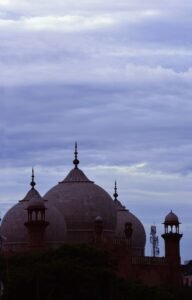Lahore Shahi Qila History: The Last 11th century`s Great Mughal Masjid

Lahore Shahi Qila History, also known as the Lahore Fort, stands as a testament to the grandeur of Mughal architecture and the rich history of Lahore, Pakistan. This magnificent fort, located in the heart of Lahore, has witnessed the rise and fall of empires and remains a symbol of cultural heritage. In this article, we explore the history, significance, and architectural marvels of the Lahore Shahi Qila, along with its pros and cons as a historical site.
History of Lahore Shahi Qila:
Origins and Early History:
The origins of the Lahore Fort date back to ancient times, with the first fortifications believed to have been constructed during the reign of the Ghaznavid dynasty in the 11th century. However, the fort as we see it today owes much of its grandeur to the Mughal emperors, particularly Akbar the Great, who rebuilt it in the 16th century.
Mughal Era
During the Mughal era, the Lahore Fort was extensively expanded and renovated by successive emperors. Akbar initiated the construction of the fort in 1566, incorporating both Persian and Indian architectural styles. His grandson, Shah Jahan, known for his architectural contributions, further embellished the fort with exquisite additions such as the Sheesh Mahal (Palace of Mirrors) and the Naulakha Pavilion.
Sikh and British Periods:
In the early 19th century, the fort came under the control of the Sikh Empire, led by Maharaja Ranjit Singh. The Sikhs made significant modifications to the fort, adding structures like the Kharak Singh Haveli. Later, during British colonial rule, the fort was used as a military garrison and underwent various changes.
Post-Independence:
After Pakistan gained independence in 1947, the Lahore Fort was declared a protected heritage site. It has since been maintained by the government, and efforts have been made to preserve its historical and architectural significance.
Architectural Highlights:
The Lahore Shahi Qila is renowned for its stunning architectural features, reflecting a blend of Mughal, Persian, and Indian styles. Some of the key highlights include:
1. Sheesh Mahal: Known as the Palace of Mirrors, this opulent structure is adorned with intricate mirror work and frescoes, creating a mesmerizing effect.
2. Naulakha Pavilion: This beautifully decorated pavilion, with its white marble and precious stone inlays, is a fine example of Mughal craftsmanship.
3. Alamgiri Gate: Built by Emperor Aurangzeb, this grand entrance gate is a symbol of the fort’s defensive strength and architectural splendor.
4. Diwan-i-Aam and Diwan-i-Khas: These halls were used for public and private audiences respectively, showcasing the Mughal rulers’ administrative and social practices.
5. Moti Masjid: A pearl-like mosque built by Shah Jahan, reflecting the elegance and simplicity of Mughal religious architecture.
Pros and Cons of Lahore Shahi Qila:
Pros:
1. Historical Significance: The fort is a treasure trove of history, offering insights into the Mughal era and subsequent periods of Lahore’s history.
2. Architectural Beauty: The stunning architectural features make it a must-visit for architecture enthusiasts.
3. Cultural Heritage: As a UNESCO World Heritage Site, it plays a crucial role in preserving Pakistan’s cultural heritage.
4. Tourist Attraction: It attracts tourists from around the world, contributing to the local economy.
Cons:
1. Maintenance Challenges: Preserving such an ancient structure requires continuous effort and resources, often posing significant challenges.
2. Pollution and Environmental Damage: Urban pollution and environmental factors can cause damage to the delicate architecture.
3. Overcrowding: As a popular tourist destination, the fort can become overcrowded, affecting the visitor experience.
FAQs of Lahore Shahi Qila History:
Q1: What is the historical significance of the Lahore Shahi Qila?
A1: The Lahore Shahi Qila is significant for its rich history, spanning several centuries and multiple empires, particularly the Mughal era, during which it was extensively developed and embellished.
Q2: Who built the Lahore Fort?
A2: The Lahore Fort, as it stands today, was largely constructed by Mughal Emperor Akbar in the 16th century, with subsequent additions by emperors like Shah Jahan and Aurangzeb.
Q3: What are the main attractions within the Lahore Fort?
A3: Key attractions include the Sheesh Mahal, Naulakha Pavilion, Alamgiri Gate, Diwan-i-Aam, Diwan-i-Khas, and the Moti Masjid.
Q4: Is the Lahore Shahi Qila a UNESCO World Heritage Site?
A4: Yes, the Lahore Shahi Qila is designated as a UNESCO World Heritage Site, recognizing its historical and cultural significance.
Q5: What challenges does the Lahore Fort face today?
A5: The fort faces challenges such as maintenance difficulties, environmental damage due to pollution, and overcrowding by tourists.
Conclusion:
The Lahore Shahi Qila stands as a majestic reminder of Pakistan’s rich history and architectural brilliance. Its intricate designs and historical significance make it a cherished heritage site. While it faces challenges in preservation, its cultural value and allure continue to attract visitors from around the globe, ensuring that the legacy of the Mughal era and Lahore’s storied past live on.
visit our site : https://timebuissnesnews.com/






